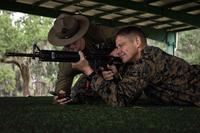As 2010 draws to a close we here at DoDBuzz thought we'd put together a list of some of the top stories in defense policy and acquisition over the past year. Hmm, guess what the recurring theme is; declining budgets.
First up: The Pentagon's $100 Billion Efficiencies initiative. Defense Secretary Robert Gates' effort to shave $100 billion off of overhead costs and reinvest that cash in research and procurement accounts made its way into nearly every defense spending story of the year. While this might have been the Pentagon's way of participating in federal belt-tightening without cutting major weapons buys, it now appears this may not be enough for the budget hawks in the White House and on Capitol Hill.
Next: All things Afghanistan. This is probably tied with the efficiency effort and potential budget cuts as the driver behind most defense-related stories of the year. From Gen. Stanley McChrystal's firing for insubordination and replacement by Iraq surge architect Gen. David Petraeus and subsequent upticks in drone strikes to the completion and implementation of the 30,000-troop surge and the debate about a 2011 versus 2014, or later, pullout of U.S. forces. This story was and is, for obvious reasons, the short-term focus of most people involved in defense policy.
Coming in behind those are the budget hawks on the right and left who want to see the Pentagon take part in its share of federal spending cuts. This includes everyone from Tea Partiers newly elected to Congress to President Obama's own deficit reduction panel that recommends cutting $100 billion from defense coffers, in part, by slashing troubled big-ticket weapon buys like the F-35B Joint Strike Fighter to the Marines' Expeditionary Fighting Vehicle. The potential will no doubt, have a serious impact on the way the military modernizes and they types of missions it will be able to conduct in the coming decades. It will be truly fascinating to see how this debate plays out over the coming months.
In fourth are the massive defense cuts that the United Kingdom will make over the coming years. In addition to the cuts serving as a forecast of things to come this side of the pond, the cuts had very real implications for U.S. defense programs. In particular, the F-35. When the Brits unveiled their cuts, they revealed they were slashing their buy of nearly 140 short take-off and vertical landing F-35Bs and swapping them for an unknown number of F-35C carrier variants.
Speaking of the F-35, this list wouldn't be complete without mentioning the massive restructuring of the beleaguered program that kicked off in February 2010. We saw a two star general fired as program manager and replaced with a three star admiral, cash withheld from Lockheed, a new timeline for the program and revised cost estimates for the planes. The best part is, less than one year later, it appears we're about to see another round of delays and cost increases resulting from the most thorough scrub of the program done to-date, known as the Technical Baseline Review.
Next comes KC-X: Early in the year, it appeared Boeing might be the sole bidder for the $35 billion contract after EADS former partner in the effort, Northrop Grumman, announced it wouldn't be bidding due to an RfP that favored Boeing's smaller 767 based offering to the EADS-Northrop Airbus A330-based KC-45. All that changed however, when EADS North America officials decided to pony up and bid on the massive contract in an all out effort to gain a serious foothold in the U.S. defense market. All this came as lawmakers supporting Boeing tried their hardest to get the Pentagon to disqualify EADS from bidding. But wait, it gets better. just when we all thought it was (relatively) smooth sailing and KC-X was on track for an award sometime close to now, we found out that the Air Force mistakenly sent EADS and Boeing information on each other's bids. While the Air Force claims no "price sensitive" information was sent to the bidders, Senator Carl Levin is planning hearings on the matter and no one can completely rule out the possibility of another protest over the error.
Next up: The withdrawal of "combat troops" from Iraq. Yes, we still have tens of thousands of soldiers on the ground there in a train-and-assist role, many of whom are doing the same missions with the same equipment they were doing before the official withdrawal of combat troops. Still, this was a huge turning point in both the Iraq war and the Afghan war. Pulling resources from a relatively, and that's a serious relatively, stable Iraq and pouring them into the fight in Afghanistan has been seen as critical to helping win, whatever that means, the fight in the Taliban heartland.
After that we've got the Quadrennial Defense Review that prompted many to wonder if it was still needed. While the document pointed to a Pentagon that will need to prepare to fight over the vast distances of the Pacific ocean with increased collaboration between the Air Force and Navy, it didn't zero in on any particular weapons programs or force structure changes as needed or unneeded.
Then there's the National Security Strategy: That document, released in May, is designed to influence the defense posture of the U.S. in light of 21st Century challenges identifies economic welfare as the number once guarantee of national security power and calls for the use of soft power ahead of military power to solve problems in the world's hot spots. It routinely calls for the U.S. to get government spending under control, jump-starting the economy and warns against an over-reliance on the military to solve problems. This document seems all the more relevant now as we see the potential for serious cuts to U.S. defense budgets.
Finally, New START. The key arms control treaty ratified just last week by the U.S. Senate will see the reduction of deployed strategic nuclear missiles from more the 2,000 to roughly 1,500, pave the way for nuclear weapon modernization and see the return weapons inspectors from the U.S. and Russia at each nation's nuclear sites for the first time in more than a year.
Oh, one more. The always-lingering F-35 alternate engine program. GE and Rolls Royce's F136, the not-so-little engine that won't quit, was constantly popping up in the news. GE and F135-maker Pratt & Whitney constantly traded barbs over the merits of one engine versus two. Meanwhile, Congress and the Pentagon waged the same fight; Congress for the F136, the Pentagon against it. As of last week, the outgoing Congress succeeded in keeping the F136 alive via a continuing resolution that funds DoD at FY-10 levels until March. We'll see what happens when the new Congress actually takes up the FY-11 spending bill. If Rep. Buck McKeon, the new chair of the House Armed Services Committee gets his way, we'll see the engine fight go on.







